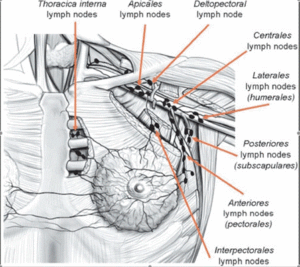Lymph nodes are part of your immune system and are present throughout your body. Their job is to filter the liquid which naturally leaks out of blood vessels. This liquid (the lymph) travels to the nodes which contain lots of white blood cells designed to trap and fight germs which can cause infection. You may have felt swollen lymph nodes in your neck when you have had an infection such as a simple cold. As well as trapping germs, the lymph nodes can also trap cancer cells that have migrated from a primary tumour.
It is often not possible to tell how many nodes contain melanoma until after your operation. The nodes removed from the armpit are carefully looked at under a microscope. Your doctor will have already felt your armpit to see if there are any lumps and you will have had a special scan (CT or MRI) to look more closely at the nodes or had a sentinel node biopsy. Nodes can feel big if there is infection in the area, so if you can feel a lump in your armpit it does not necessarily mean that the cancer has spread.
If there is only a small amount of cancer cells present in the nodes then the armpit can feel normal and look normal on scan. This is often why we do not know if the cancer has spread to the nodes until they have been looked at under a microscope.
There are hundreds of lymph nodes throughout your body which will still be there to fight infection after your operation. However you will be at increased risk of infection in the affected limb.

